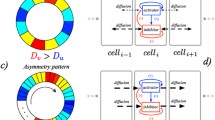Abstract
Several current reaction-diffusion mechanisms have been proposed as models for morphogenesis in the Turing (1952,Phil. Trans. R. Soc. Lond. B 237, 37–72) sense. We introduce and exploit a quantity, we have termed heterogeneity, which allows us to elaborate the differences between the various models with regard to spatial pattern formation. It is shown that this quantity provides a concise view for the comparison of theoretical models with experimental observations. Two model mechanisms are treated explicitly both for linear and for biased diffusion.
Similar content being viewed by others
Literature
Aris, R. 1975.The Mathematical Theory of Diffusion and Reaction in Permeable Catalysts. Oxford: Clarendon Press.
Auchmuty, J. G. and G. Nicolis. 1975. “Bifurcation Analysis of Nonlinear Reaction-Diffusion-Equations—I”.Bull. math. Biol.,37, 1–43.
Brown, K. J. and J. C. Eilbeck 1982. “Bifurcation, Stability Diagrams, and Varying Diffusion Coefficients in Reaction-Diffusion-Equations”.Bull. math. Biol. 44, 87–102.
Kai Lai Chung. 1974.Elementary Probability Theory with Stochastic Processes. Berlin: Springer.
Conway, E. D. Hoff and J. Smoller. 1978. “Large Time Behaviour of Solutions of Systems of Nonlinear Reaction-diffusion Equations”.SIAM. J. appl. Math. 35, 1–16.
Crank, J. 1975.Mathematics of Diffusion, 2nd Edn. Oxford: Oxford University Press.
Dick, D. A. T. 1959. “The Rate of Diffusion of Water in the Protoplasm of Living Cells”.Expl Cell Res. 17, 5–13.
Erneux, T. and E. L. Reiss. 1984. “Singular Secondary Bifurcation”.SIAM J. appl. Math. 44(3).
Gierer, A. and H. Meinhardt. 1972. “A Theory of Biological Pattern Formation”.Kybernetik 12, 30–39.
— S. Berking, H. Bode, C. N. David, K. Flick, G. Hansmann, H. Schaller and E. Trenckner. 1972. “Regeneration of Hydra from Reaggregated Cells”.Nature New Biol. 239, 98–101.
Haken, H. 1978.Synergetics. An Introduction. Berlin: Springer.
Kubicek, M., V. Ryzler and M. Marek. 1978. “Spatial Structures in a Reaction-Diffusion System—Detailed Analysis of the Brusselator”.Biophys. Chem. 8, 235–256.
Li, R.-S. and G. Nicolis. 1981. “Bifurcation Phenomena in Nonideal Systems”.J. Phys. Chem. 85, 1912–1918.
Marek, M. and M. Kubicek. 1981. “Morphogen Pattern Formation and Development in Growth”.Bull. math. Biol. 43, 259–270.
Meinhardt, H. 1982.Models of Biological Pattern Formation. London: Academic Press.
Murray, J. D. 1977.Lectures on Nonlinear-Differential-Equation Models in Biology. Oxford: Clarendon Press.
— 1981. “A Pre-pattern Formation Mechanisms for Animal Coat Markings”.J. theor. Biol. 88, 161.
— 1982. “Parameter Space for Turning Instability in Reaction-Diffusion Mechanism: a Comparison of Models”.J. theor. Biol. 98, 143–163.
Nandapurkar, P. and V. Hlavacek. 1984. “Concentration-dependent Diffusion Coefficient and Dissipative Structures”.Bull. math. Biol. 40, 269–282.
Othmer, H. G. 1977. “Current Problems in Pattern Formation”.Lecture Notes Math. 9, 57.
Rosen, G. 1975. “Solutions to Systems of Nonlinear Reaction-Diffusion Equations”.Bull. math. Biol. 37, 277–288.
Sattinger, D., 1973.Topics in Stability and Bifurcation Theory.Lecture Notes Math. Vol. 308. Berlin: Springer.
Smirnov, V. I. 1964.A Course of Higher Mathematics, Vol. V. Oxford: Pergamon Press.
Smoller, J. 1983.Shock Waves and Reaction-Diffusion Equations. Berlin: Springer.
Thomas, D. 1975. “Artificial Enzyme Membranes, Transport, Memory and Oscillatory Phenomena”. InInternational Symposium on Analysis and Control of Immobilized Enzyme Systems, D. Thomas and J. P. Kernevez (Eds), pp. 115–150.
Turing, A. M. 1952. “The Chemical Basis of Morphogenesis”.Phil. Trans. R. Soc. Lond. B 237, 37–72.
Wolpert, L. 1969. “Positional Information and the Spatial Pattern of Cellular Differentiation”.J. theor. Biol. 25, 1–47.
Author information
Authors and Affiliations
Rights and permissions
About this article
Cite this article
Berding, C. On the heterogeneity of reaction-diffusion generated pattern. Bltn Mathcal Biology 49, 233–252 (1987). https://doi.org/10.1007/BF02459700
Received:
Revised:
Issue Date:
DOI: https://doi.org/10.1007/BF02459700




